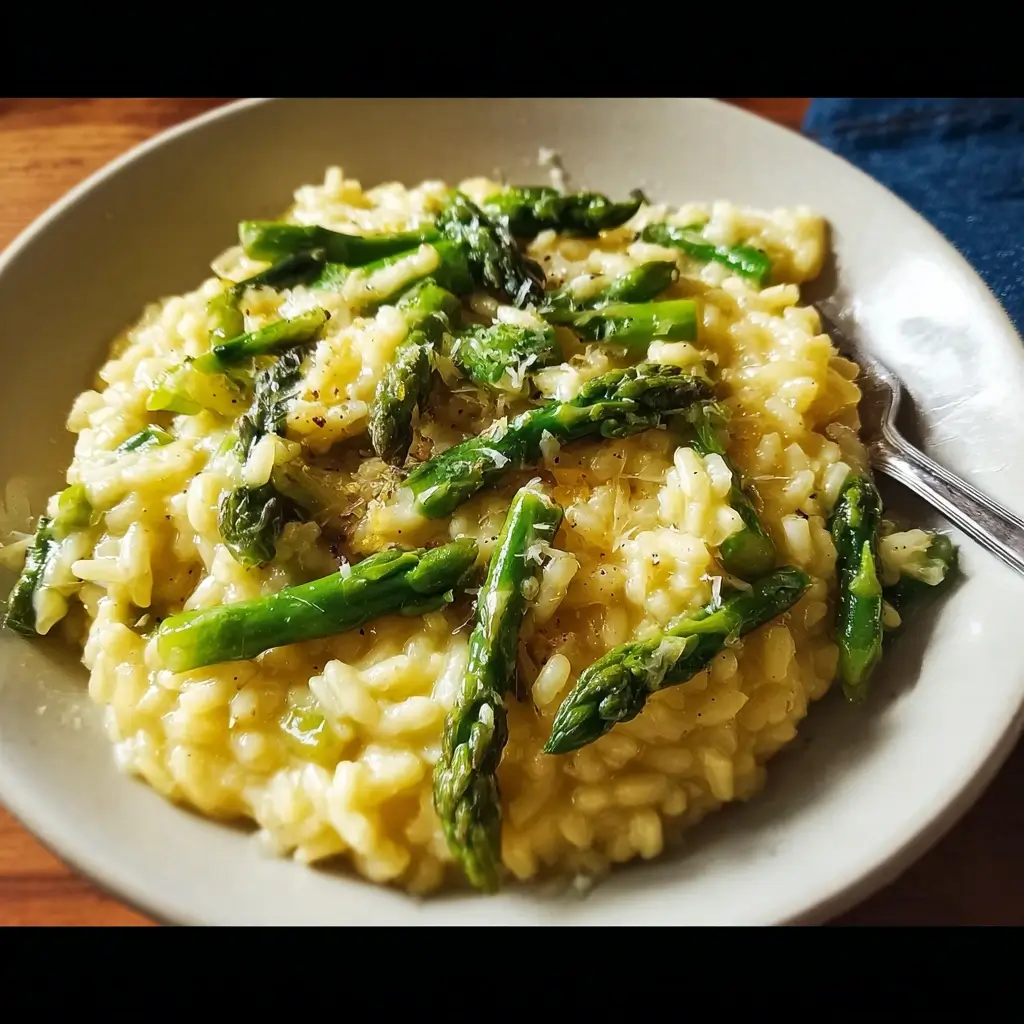Of all the dishes that signal the true arrival of spring, this Vegetarian Lemon Asparagus Risotto holds a special place in my heart and my kitchen. I remember the first time I made it for my family. We were tired of the heavy, hearty meals of winter and were craving something bright, fresh, and utterly satisfying. The skepticism was palpable; my kids, accustomed to more familiar pasta dishes, eyed the pot of simmering Arborio rice with suspicion. But as the kitchen filled with the incredible aroma of sautéed shallots, zesty lemon, and fresh asparagus, their curiosity piqued. The moment of truth came at the dinner table. The first spoonful was met with a moment of silence, followed by wide-eyed approval. The creamy, “al dente” texture of the rice, perfectly balanced by the sharp, fresh burst of lemon and the tender-crisp bite of asparagus, was a revelation. It was elegant enough for a special occasion but comforting enough for a weeknight. Since that day, this recipe has become our official “Welcome, Spring!” meal, a cherished tradition that brings a sense of renewal and vibrant flavor to our table. It’s a testament to how simple, high-quality ingredients, combined with a little patience and a lot of stirring, can create something truly magical.
The Ultimate Vegetarian Lemon Asparagus Risotto
This recipe is more than just a set of instructions; it’s a guide to creating a culinary experience. Risotto has a reputation for being difficult, but the reality is that it simply demands your attention. The process of standing over the stove, patiently stirring and adding warm broth ladle by ladle, is a meditative act that rewards you with a dish of unparalleled creaminess and depth. This version is designed to be the star of the show—a bright, zesty, and deeply satisfying main course that celebrates the best of spring produce. We will walk you through every step, from selecting the right rice to achieving that perfect, luxurious texture without a drop of heavy cream.
[Image: A beautiful overhead shot of the finished Vegetarian Lemon Asparagus Risotto in a large serving dish, garnished with Parmesan shavings and fresh dill.]
Ingredients for a Perfect Risotto
Choosing the right ingredients is the first and most crucial step in making an exceptional risotto. Quality matters here, as each component plays a distinct and important role in building the final flavor and texture.
- Olive Oil: 2 tablespoons, extra virgin. Use a good quality oil as it forms the base flavor.
- Butter: 4 tablespoons, unsalted, divided. Two tablespoons are for sautéing, and the crucial final two are for the mantecatura (the finishing step) to add creaminess and sheen.
- Shallot: 1 large (or 2 small), finely minced. Shallots provide a milder, sweeter flavor than yellow onions, which complements the delicate asparagus and lemon beautifully.
- Garlic: 2 cloves, minced. This adds a subtle aromatic depth without overpowering the dish.
- Arborio Rice: 1 ½ cups. This is the star of the show. Arborio is a short-grain Italian rice with a high starch content (amylopectin), which is released during the slow cooking process to create the signature creamy sauce of a true risotto. Do not rinse the rice, as this will wash away the essential starches.
- Dry White Wine: ½ cup. Use a crisp, dry wine like a Sauvignon Blanc, Pinot Grigio, or an unoaked Chardonnay. The wine’s acidity cuts through the richness and adds a complex layer of flavor. If you prefer to cook without alcohol, you can substitute it with an equal amount of vegetable broth with an added squeeze of lemon juice.
- Vegetable Broth: 6 to 7 cups. It is absolutely essential that the broth is kept at a gentle simmer in a separate pot throughout the cooking process. Adding cold broth to the hot rice will shock the grains and hinder the starch-release process. Use a high-quality, flavorful broth, as it will be absorbed entirely by the rice.
- Asparagus: 1 bunch (about 1 pound). Look for firm, bright green stalks. You’ll want to trim the tough, woody ends. We will be slicing the tender stalks into bite-sized pieces, leaving the delicate tips whole for a beautiful presentation.
- Lemon: 1 large. We will use both the zest and the juice. The zest provides a fragrant, floral lemon aroma, while the juice, added at the end, gives a bright, acidic kick that lifts all the flavors.
- Parmesan Cheese: ¾ cup, freshly grated, plus more for serving. Please, do not use pre-shredded cheese. It often contains anti-caking agents that prevent it from melting smoothly. A freshly grated block of Parmigiano-Reggiano will melt into a luscious, savory, and nutty dream.
- Fresh Parsley or Dill: 2 tablespoons, finely chopped, for garnish. This adds a final touch of freshness and color.
- Salt: 1 teaspoon, or to taste.
- Black Pepper: ½ teaspoon, freshly ground.
Step-by-Step Instructions: The Art of Risotto
Follow these detailed steps closely. The key is in the technique—the patient stirring and the gradual addition of warm broth. Put on some music, pour yourself a glass of that white wine, and enjoy the process.
Step 1: Preparation (Mise en Place)
Before you even think about turning on the stove, get all your ingredients prepped and ready. Risotto waits for no one, so having everything at your fingertips is essential.
- Prepare the Broth: Pour your 6-7 cups of vegetable broth into a medium saucepan. Bring it to a gentle simmer over medium-low heat. Keep it warm throughout the entire cooking process. This is non-negotiable for a creamy risotto.
- Prepare the Asparagus: Wash the asparagus and snap off the tough, woody ends. A good trick is to bend a stalk near the bottom; it will naturally break where the tender part begins. Discard the ends. Slice the tender stalks on a diagonal into ½-inch pieces, keeping the delicate tips separate.
- Prepare the Aromatics and Cheese: Finely mince the shallot and garlic. Grate your Parmesan cheese. Zest the entire lemon first, then cut it in half to juice later. Chop your fresh herbs for the garnish.
Step 2: Building the Flavor Base
- Sauté the Aromatics: In a large, heavy-bottomed pot or Dutch oven, melt 2 tablespoons of butter with 2 tablespoons of olive oil over medium heat. Once the butter is foaming, add the minced shallot. Sauté for 3-4 minutes until softened and translucent, but not browned. Add the minced garlic and cook for another minute until fragrant.
- Blanch the Asparagus Tips: While the shallots are cooking, add the reserved asparagus tips to your simmering broth for just 1-2 minutes until they turn bright green and are slightly tender. Using a slotted spoon, remove them and set them aside. This will be your garnish, ensuring they are perfectly cooked and vibrant.
Step 3: Toasting the Rice (Tostatura)
- Toast the Grains: Add the 1 ½ cups of Arborio rice to the pot with the shallots and garlic. Stir continuously for about 2 minutes. The grains will become translucent around the edges with a small, opaque white dot in the center. This toasting process helps the grains absorb the liquid more evenly and prevents them from becoming mushy.
Step 4: Deglazing and the First Liquid Addition
- Add the Wine: Pour in the ½ cup of dry white wine. The pot will sizzle and steam. Stir constantly, scraping up any browned bits from the bottom of the pan. Cook until the wine has been almost completely absorbed by the rice and the smell of alcohol has cooked off, leaving behind its wonderful flavor.
Step 5: The Rhythmic Stirring Process
This is the heart of making risotto. The goal is to gradually add the warm broth, one ladle at a time, allowing the rice to absorb it fully before adding the next. The constant, gentle stirring rubs the rice grains against each other, encouraging them to release their starches and form a creamy sauce.
- First Ladle of Broth: Add one ladleful (about ¾ cup) of the simmering vegetable broth to the rice. Stir gently but consistently until the liquid is almost fully absorbed. The heat should be at a medium-low, maintaining a lively simmer but not a rolling boil.
- Continue the Process: Continue adding the broth, one ladle at a time, waiting for each addition to be absorbed before adding the next. Keep stirring. This process will take about 18-22 minutes. You’ll notice the risotto becoming progressively creamier.
- Add the Asparagus Stalks: After about 12-15 minutes of stirring, when the risotto is about halfway cooked, stir in the sliced asparagus stalks (not the tips you blanched earlier). They will cook along with the rice for the final 5-7 minutes, becoming perfectly tender-crisp.
Step 6: Checking for Doneness
After about 18 minutes, start tasting the rice. The perfect risotto is “al dente”—creamy and soft on the outside but with a slight bite or firmness in the center of each grain. It should be cooked through but not mushy. The overall consistency should be fluid and saucy, like a thick porridge. If it looks stiff, add another splash of broth.
Step 7: The Final Flourish (Mantecatura)
This is the final, magical step that transforms a good risotto into a great one.
- Remove from Heat: Once the risotto has reached the desired consistency, remove the pot from the heat. It’s crucial to do this off the heat to prevent the cheese from becoming stringy and the butter from separating.
- Add the Finishing Touches: Vigorously stir in the remaining 2 tablespoons of cold butter, the ¾ cup of freshly grated Parmesan cheese, the lemon zest, and the juice of half a lemon. Stir until the butter and cheese have completely melted, creating a luxuriously creamy and glossy finish.
- Season and Rest: Taste the risotto one last time. Adjust for seasoning, adding more salt, pepper, or another squeeze of lemon juice if needed. The lemon should be bright but not overpowering. Cover the pot and let it rest for 2 minutes. This allows the flavors to meld and the risotto to settle into its final, perfect consistency.
[Image: A step-by-step collage showing the risotto process: toasting the rice, adding the first ladle of broth, the creamy mid-point, and the final ‘mantecatura’ step with cheese and butter.]
Nutrition Facts
- Servings: 4 main course servings or 6 appetizer servings
- Calories per Serving: Approximately 580 kcal (for a main course serving)
Disclaimer: The nutritional information provided is an estimate and can vary based on the specific ingredients and quantities used.
Preparation and Cooking Time
- Prep Time: 15 minutes
- Cook Time: 25-30 minutes
- Total Time: Approximately 45 minutes
How to Serve Your Lemon Asparagus Risotto
Serving risotto is all about timing and presentation. It is best enjoyed immediately after it’s made, as it tends to thicken upon sitting.
- Plating:
- Spoon a generous portion into warm, shallow bowls.
- Gently tap the bottom of the bowl on the counter to help the risotto spread out evenly in a perfect circle. This is the classic Italian way to serve it.
- Garnishes are Key: A few simple garnishes can elevate the dish from homemade to restaurant-quality.
- Blanched Asparagus Tips: Artfully arrange the bright green asparagus tips you set aside earlier on top of each serving.
- Parmesan: Add a few shavings of Parmesan cheese using a vegetable peeler.
- Fresh Herbs: Sprinkle with freshly chopped parsley or dill for a pop of color and freshness.
- Black Pepper: A final grind of fresh black pepper adds a touch of spice.
- Lemon: A thin slice or wedge of lemon on the side of the bowl looks beautiful and allows guests to add more citrusy brightness if they desire.
- Olive Oil: A very light drizzle of a high-quality, finishing olive oil can add a lovely sheen and a peppery note.
- Pairings:
- Wine: Pair with the same crisp white wine you used for cooking, such as a Sauvignon Blanc or Pinot Grigio. Its acidity will cut through the richness of the risotto perfectly.
- Bread: Serve with warm, crusty bread or garlic bread for sopping up any remaining creamy sauce.
- Salad: A simple side salad with a light vinaigrette, such as a mix of arugula and shaved fennel, provides a refreshing contrast to the creamy risotto.
5 Additional Tips for Risotto Perfection
- Warm Broth is Non-Negotiable: It might seem like an extra step, but keeping your broth at a gentle simmer in a separate pot is the most critical rule of risotto making. Adding cold liquid will cool everything down, shock the rice grains, and drastically slow the cooking process, resulting in a less creamy, unevenly cooked dish.
- Choose the Right Pot: A wide, heavy-bottomed pot or Dutch oven is your best friend for making risotto. The wide surface area allows the rice to cook in a shallow layer, promoting even cooking and broth evaporation. A heavy base ensures excellent heat distribution and prevents the rice from scorching on the bottom.
- Don’t Abandon Your Post: Risotto is a dish that requires your love and attention. While you don’t need to stir frantically and without pause, you should stir frequently and consistently. This agitation is what coaxes the starches out of the rice to create that natural cream sauce. Use the time to relax, listen to a podcast, and enjoy the delicious aromas.
- Master the ‘All’Onda’ Consistency: In Italy, the perfect risotto texture is described as all’onda, which means “on the wave.” This means it should be fluid enough to flow in a gentle wave if you tilt the plate. It should not be a stiff, sticky mound, nor should it be a watery soup. If your risotto is too thick when you finish, don’t be afraid to stir in one last splash of warm broth right before serving to loosen it up.
- Salt in Stages: Seasoning is key. Salt the shallots when you first sauté them to draw out moisture and build flavor. Your vegetable broth will also contain salt, so be mindful of that. Taste the risotto about halfway through the cooking process and then again at the very end, after adding the salty Parmesan cheese. Adjust the final seasoning only after you’ve incorporated all the ingredients.
[Image: A close-up shot of a spoon lifting a creamy bite of risotto from a bowl, showcasing the al dente rice grains and pieces of asparagus.]
Frequently Asked Questions (FAQ)
Q1: Can I make this risotto vegan?
A: Absolutely! This recipe is easily adaptable for a vegan diet. Simply make the following substitutions: use a high-quality vegan butter or an additional two tablespoons of olive oil in place of the dairy butter. For the Parmesan cheese, you can use a store-bought vegan Parmesan alternative or make your own by blending 1 cup of raw cashews with 3-4 tablespoons of nutritional yeast, ½ teaspoon of garlic powder, and a pinch of salt. The nutritional yeast provides a wonderful cheesy, umami flavor.
Q2: My risotto isn’t creamy. What did I do wrong?
A: There are a few common culprits for a non-creamy risotto. First, ensure you used the correct type of rice (Arborio, Carnaroli, or Vialone Nano) and that you did not rinse it. Second, the issue could be the broth temperature—always use warm broth. Third, the stirring process is essential for releasing starches; if you simply add all the liquid at once and cover the pot, you’re just making boiled rice. Finally, don’t skip the final mantecatura step of vigorously stirring in the cold butter and Parmesan off the heat; this is what creates that final, emulsified, creamy coating.
Q3: Can I use a different vegetable besides asparagus?
A: Yes, this risotto recipe is a fantastic base for other vegetables. In the spring, fresh English peas (stirred in during the last 3-4 minutes) are a classic and delicious addition. In the fall, you could use roasted butternut squash (stirred in at the end) or sautéed wild mushrooms (cooked separately and added with the cheese). In the summer, try diced zucchini or corn. Just be mindful of the different cooking times for each vegetable.
Q4: Can I make risotto ahead of time or reheat leftovers?
A: Risotto is notoriously best when eaten immediately. As it cools, the starches seize up, and it can become thick and clumpy. However, you can reheat leftovers with a bit of care. Add the risotto to a pan with a generous splash of broth or water over low heat. Stir gently but constantly until it is warmed through and has regained some of its creamy consistency. It won’t be quite as perfect as when it was fresh, but it will still be delicious. For parties, some chefs “par-cook” the risotto by cooking it about 75% of the way, spreading it on a baking sheet to cool quickly, and then finishing it to order with the last few ladles of broth and the mantecatura step.
Q5: What if I don’t want to use white wine?
A: The white wine adds a crucial layer of acidity and complexity, but if you prefer to omit it, you can. The best substitute is to use an equal amount (½ cup) of your warm vegetable broth mixed with one tablespoon of lemon juice or a light-colored vinegar like white wine vinegar. This will mimic the acidity that the wine provides, which is important for balancing the richness of the final dish. Add this mixture at the same step you would have added the wine and cook until it is fully absorbed before you begin adding the rest of the broth.
Print
Vegetarian Lemon Asparagus Risotto Recipe
Ingredients
- Olive Oil: 2 tablespoons, extra virgin. Use a good quality oil as it forms the base flavor.
- Butter: 4 tablespoons, unsalted, divided. Two tablespoons are for sautéing, and the crucial final two are for the mantecatura (the finishing step) to add creaminess and sheen.
- Shallot: 1 large (or 2 small), finely minced. Shallots provide a milder, sweeter flavor than yellow onions, which complements the delicate asparagus and lemon beautifully.
- Garlic: 2 cloves, minced. This adds a subtle aromatic depth without overpowering the dish.
- Arborio Rice: 1 ½ cups. This is the star of the show. Arborio is a short-grain Italian rice with a high starch content (amylopectin), which is released during the slow cooking process to create the signature creamy sauce of a true risotto. Do not rinse the rice, as this will wash away the essential starches.
- Dry White Wine: ½ cup. Use a crisp, dry wine like a Sauvignon Blanc, Pinot Grigio, or an unoaked Chardonnay. The wine’s acidity cuts through the richness and adds a complex layer of flavor. If you prefer to cook without alcohol, you can substitute it with an equal amount of vegetable broth with an added squeeze of lemon juice.
- Vegetable Broth: 6 to 7 cups. It is absolutely essential that the broth is kept at a gentle simmer in a separate pot throughout the cooking process. Adding cold broth to the hot rice will shock the grains and hinder the starch-release process. Use a high-quality, flavorful broth, as it will be absorbed entirely by the rice.
- Asparagus: 1 bunch (about 1 pound). Look for firm, bright green stalks. You’ll want to trim the tough, woody ends. We will be slicing the tender stalks into bite-sized pieces, leaving the delicate tips whole for a beautiful presentation.
- Lemon: 1 large. We will use both the zest and the juice. The zest provides a fragrant, floral lemon aroma, while the juice, added at the end, gives a bright, acidic kick that lifts all the flavors.
- Parmesan Cheese: ¾ cup, freshly grated, plus more for serving. Please, do not use pre-shredded cheese. It often contains anti-caking agents that prevent it from melting smoothly. A freshly grated block of Parmigiano-Reggiano will melt into a luscious, savory, and nutty dream.
- Fresh Parsley or Dill: 2 tablespoons, finely chopped, for garnish. This adds a final touch of freshness and color.
- Salt: 1 teaspoon, or to taste.
- Black Pepper: ½ teaspoon, freshly ground.
Instructions
Step 1: Preparation (Mise en Place)
Before you even think about turning on the stove, get all your ingredients prepped and ready. Risotto waits for no one, so having everything at your fingertips is essential.
- Prepare the Broth: Pour your 6-7 cups of vegetable broth into a medium saucepan. Bring it to a gentle simmer over medium-low heat. Keep it warm throughout the entire cooking process. This is non-negotiable for a creamy risotto.
- Prepare the Asparagus: Wash the asparagus and snap off the tough, woody ends. A good trick is to bend a stalk near the bottom; it will naturally break where the tender part begins. Discard the ends. Slice the tender stalks on a diagonal into ½-inch pieces, keeping the delicate tips separate.
- Prepare the Aromatics and Cheese: Finely mince the shallot and garlic. Grate your Parmesan cheese. Zest the entire lemon first, then cut it in half to juice later. Chop your fresh herbs for the garnish.
Step 2: Building the Flavor Base
- Sauté the Aromatics: In a large, heavy-bottomed pot or Dutch oven, melt 2 tablespoons of butter with 2 tablespoons of olive oil over medium heat. Once the butter is foaming, add the minced shallot. Sauté for 3-4 minutes until softened and translucent, but not browned. Add the minced garlic and cook for another minute until fragrant.
- Blanch the Asparagus Tips: While the shallots are cooking, add the reserved asparagus tips to your simmering broth for just 1-2 minutes until they turn bright green and are slightly tender. Using a slotted spoon, remove them and set them aside. This will be your garnish, ensuring they are perfectly cooked and vibrant.
Step 3: Toasting the Rice (Tostatura)
- Toast the Grains: Add the 1 ½ cups of Arborio rice to the pot with the shallots and garlic. Stir continuously for about 2 minutes. The grains will become translucent around the edges with a small, opaque white dot in the center. This toasting process helps the grains absorb the liquid more evenly and prevents them from becoming mushy.
Step 4: Deglazing and the First Liquid Addition
- Add the Wine: Pour in the ½ cup of dry white wine. The pot will sizzle and steam. Stir constantly, scraping up any browned bits from the bottom of the pan. Cook until the wine has been almost completely absorbed by the rice and the smell of alcohol has cooked off, leaving behind its wonderful flavor.
Step 5: The Rhythmic Stirring Process
This is the heart of making risotto. The goal is to gradually add the warm broth, one ladle at a time, allowing the rice to absorb it fully before adding the next. The constant, gentle stirring rubs the rice grains against each other, encouraging them to release their starches and form a creamy sauce.
- First Ladle of Broth: Add one ladleful (about ¾ cup) of the simmering vegetable broth to the rice. Stir gently but consistently until the liquid is almost fully absorbed. The heat should be at a medium-low, maintaining a lively simmer but not a rolling boil.
- Continue the Process: Continue adding the broth, one ladle at a time, waiting for each addition to be absorbed before adding the next. Keep stirring. This process will take about 18-22 minutes. You’ll notice the risotto becoming progressively creamier.
- Add the Asparagus Stalks: After about 12-15 minutes of stirring, when the risotto is about halfway cooked, stir in the sliced asparagus stalks (not the tips you blanched earlier). They will cook along with the rice for the final 5-7 minutes, becoming perfectly tender-crisp.
Step 6: Checking for Doneness
After about 18 minutes, start tasting the rice. The perfect risotto is “al dente”—creamy and soft on the outside but with a slight bite or firmness in the center of each grain. It should be cooked through but not mushy. The overall consistency should be fluid and saucy, like a thick porridge. If it looks stiff, add another splash of broth.
Step 7: The Final Flourish (Mantecatura)
This is the final, magical step that transforms a good risotto into a great one.
- Remove from Heat: Once the risotto has reached the desired consistency, remove the pot from the heat. It’s crucial to do this off the heat to prevent the cheese from becoming stringy and the butter from separating.
- Add the Finishing Touches: Vigorously stir in the remaining 2 tablespoons of cold butter, the ¾ cup of freshly grated Parmesan cheese, the lemon zest, and the juice of half a lemon. Stir until the butter and cheese have completely melted, creating a luxuriously creamy and glossy finish.
- Season and Rest: Taste the risotto one last time. Adjust for seasoning, adding more salt, pepper, or another squeeze of lemon juice if needed. The lemon should be bright but not overpowering. Cover the pot and let it rest for 2 minutes. This allows the flavors to meld and the risotto to settle into its final, perfect consistency.
Nutrition
- Serving Size: One Normal Portion
- Calories: 580





